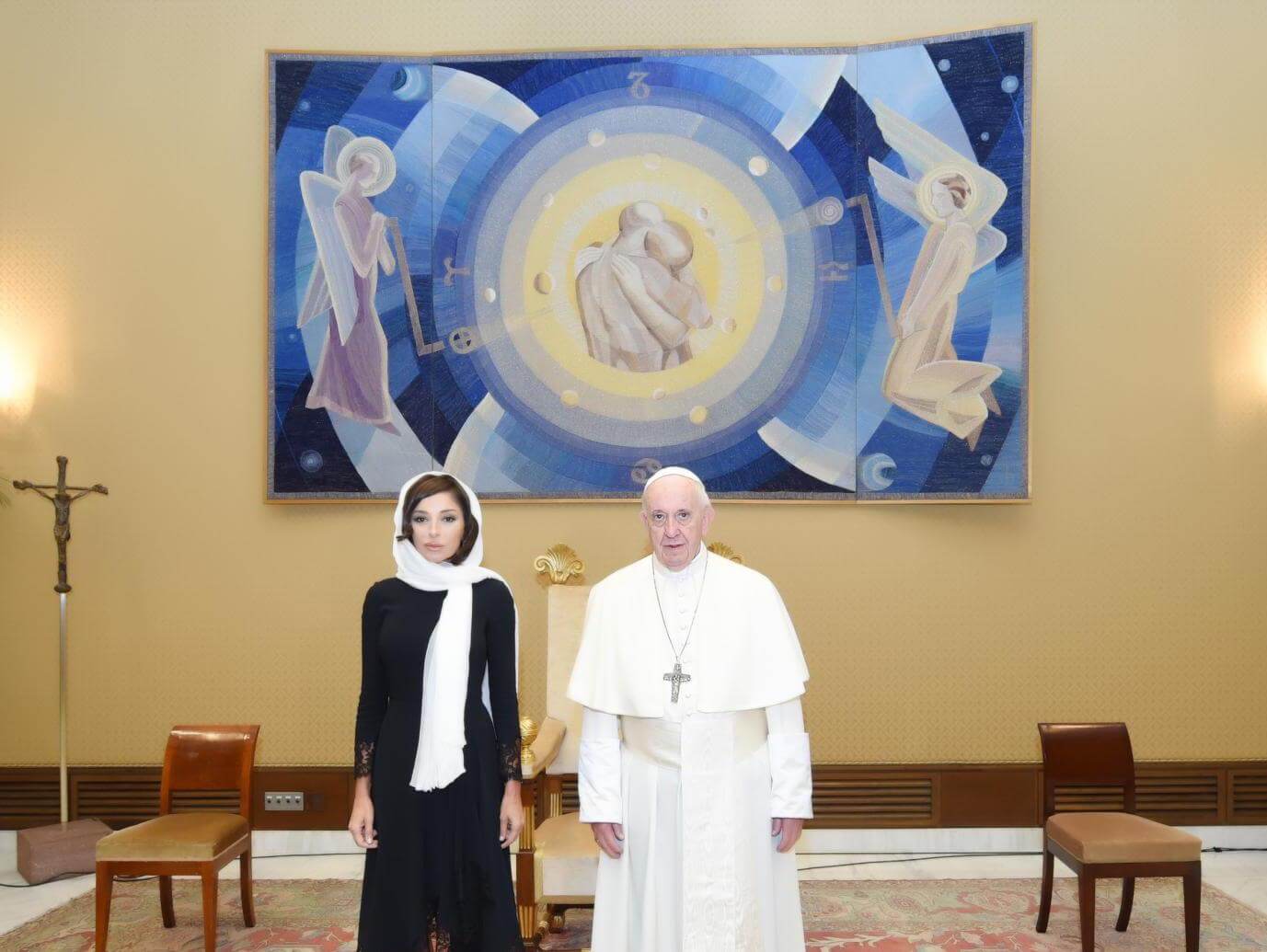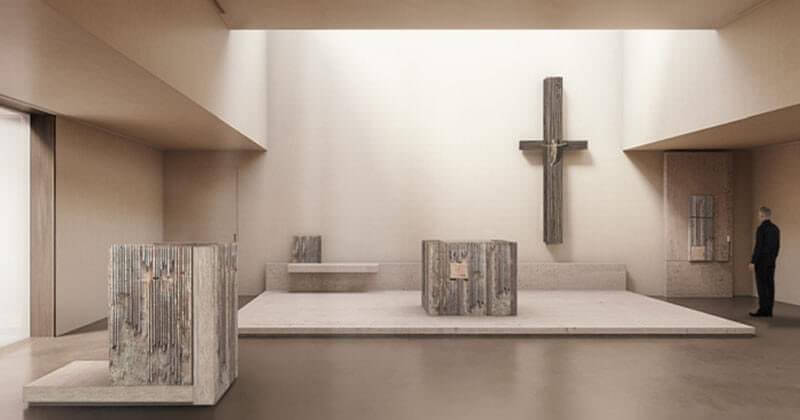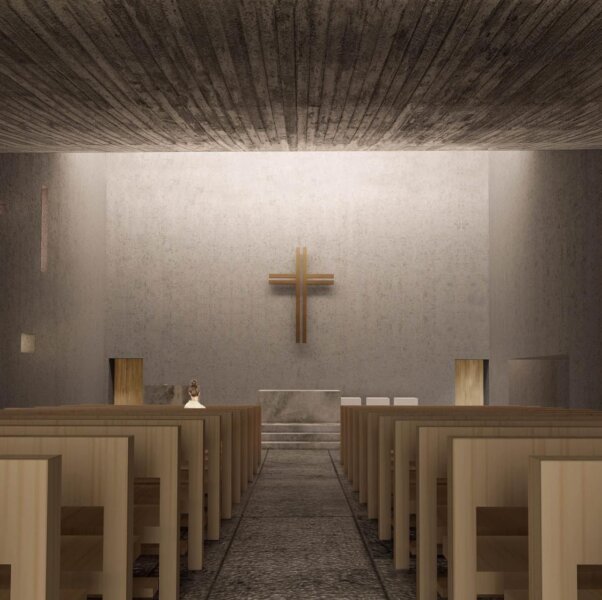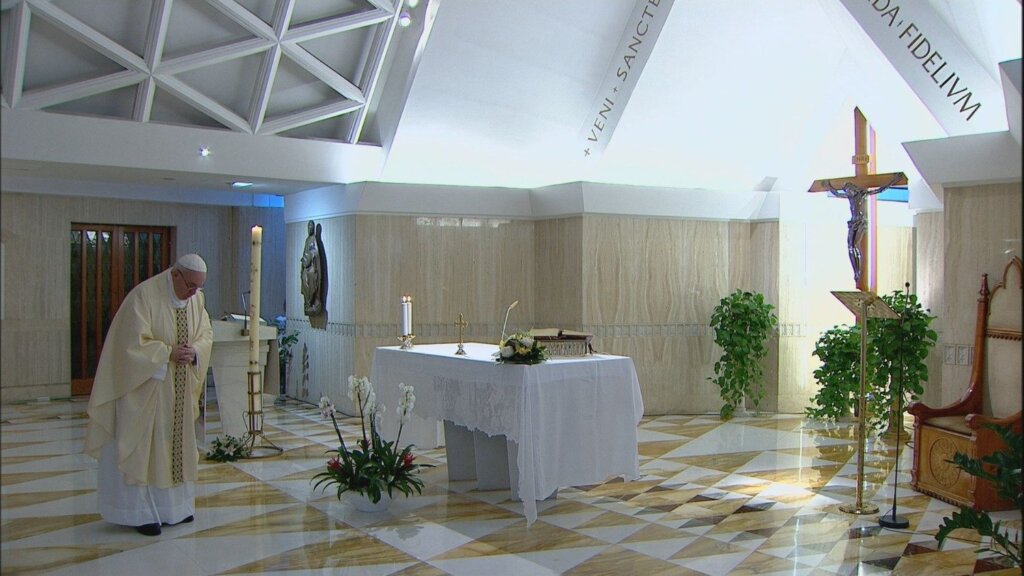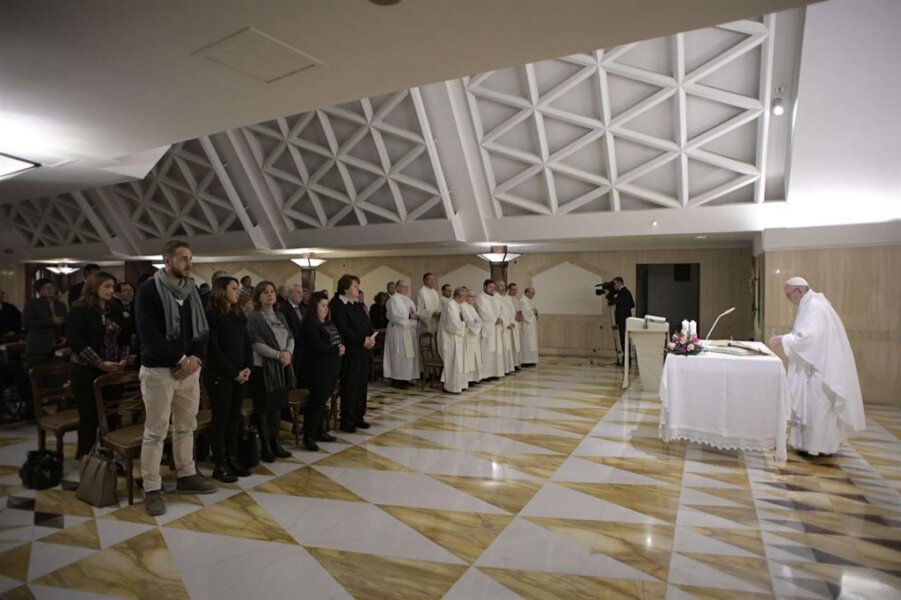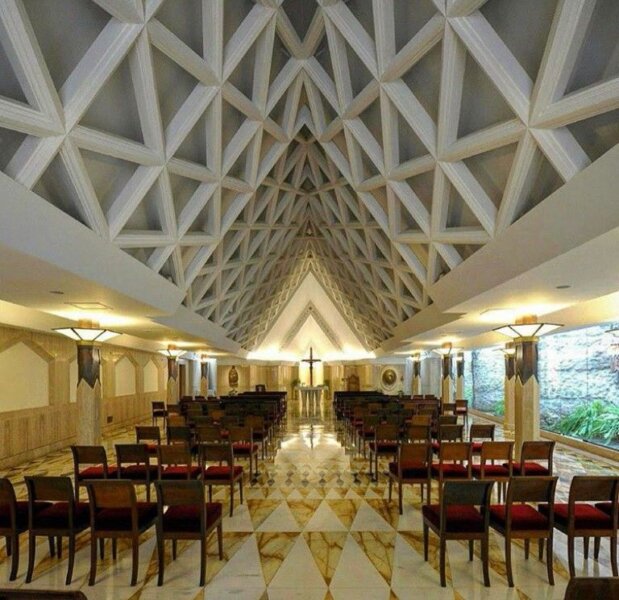Above: Azerbaijani First Vice-President Mehriban Aliyeva with Pope Francis.
In his extraordinary Gifford Lectures of 2012, The Face of God, British philosopher and musician Roger Scruton talks about the “defacement” that occurs in temples and buildings when human proportions, cultural references, and richness of beauty are avoided in favor of empty, blank, machine-like, impersonal qualities. The discussion is fascinating; I can’t do justice to it in this short article, but I highly recommend the book, which is one of the most exciting I’ve read in a long time. Scruton addresses the iconoclastic drive that has dominated now for roughly a century:
Sacred places are the first places to be destroyed by invaders and iconoclasts, for whom nothing is more offensive than the enemy’s gods. And we should recognize that much of the destruction of our environment today is deliberate, the result of a willed assault on old and despised forms of tranquillity. For there are two broad approaches to building: the way of settlement, and the way of disruption. Often when we settle we fit our lives into an existing and already consecrated pattern, strive to inherit the order established by those who have come before us, and to honour the spirit of the place: in this sense, as Heidegger points out in an important essay [“Building, Dwelling, Thinking”], to build is to dwell. But the iconoclast seeks to replace old gods with new, to disenchant the landscape and to mark the place with signs of his defiance. This iconoclastic spirit can be seen in a great many modern projects—not only in the faceless curtain walls of the new building types, but in the bleak intrusive wind farms that are eating up the landscape, or in the postmodern blemishes deliberately inserted into settled urban schemes by architects like Daniel Libeskind and Thom Mayne. (pp. 123-24)
We should pause a moment to have a look at some work by the pair of architects Scruton mentions. Here are two postmodern blemishes inserted by Libeskind into classical structures, rather like geometric tumors or balled-up pieces of metal junk dropped by a misanthropic giant:
And here is the aptly named Bill & Melinda Gates Hall at Cornell, designed by Mayne:
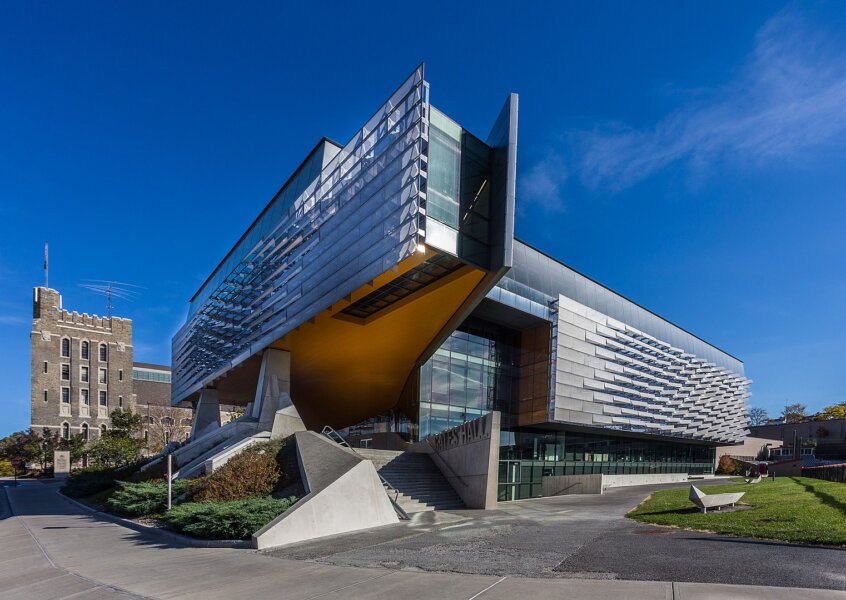
Scruton’s key insight is that iconoclasm is a rejection of the “gods of the past,” that is, the religion that has been in place until now (and, more broadly, the culture birthed and nourished by religion). Modernist church architecture is not simply a new way of doing things; it is decisively a rejection of traditional ways of doing things, and therefore unavoidably a rejection of the meaning of the old ways. It is a new system of symbols designed to replace the old system.
Last week, photos were making the rounds of two particularly hideous Catholic church designs whose architects won the Pontifical Academy Award for Sacred Architecture (see here), which was awarded to them directly by the pope. He “went on to congratulate the winners of the Pontifical Academies Award for their contributions to sacred architecture”:
The gold medal was awarded to “OPPS Architettura” studio in Florence for its work to renovate a chapel in Rome belonging to the Foundation of Sts. Francis of Assisi and Catherine of Siena. The silver medal went to the architect Federica Frino for her project for a new church dedicated to St. Thomas in the central Italian city of Pontedera. The Pontifical Academies Awards were assigned based on the criteria of “design, outfitting, liturgical adaptation, renovation, and reuse of spaces dedicated to worship, taking into account new requirements and contemporary architectural language.”
Here is the Gold Medal winner’s design:
Here is the Silver Medal winner’s design:
Readers may recall that, back in May, I dedicated two articles to articulating the differences between traditional churches and modernist churches and why the one succeeds where the other fails (see here and here). Certainly these pontifical award-winning architects, whatever the IKEAclasm of their designs, merit to be called (in Gnostic style) “pure moderns” who altogether avoid the shame of being “indietristi” or backwardists. (Are we allowed at least to whisper that they are, in fact, as backwardist as can be, given that ecclesiastical modernism was fashionable—to the extent that it was ever fashionable—some decades ago, today eliciting mostly yawns of boredom or cringes of disgust?)
There should be no surprise that Pope Francis awards architecture like this, or that he says his Mass almost every day in a chapel of hideous ugliness: it is the architecture that embodies and evokes the new Catholicism that he believes emerged in and from the Second Vatican Council, which boldly stepped on to a new path—so new that this Church must repudiate the old forms of worship.[1]
The Novus Ordo, as I have demonstrated in detail, significantly downplays the confession of the Holy Trinity and of the Divinity of Christ. To whatever extent it was intentional or accidental, this evacuation of content paved the way for what appears to be a new “trinity” confessed by the religion for which these award-winning chapels are the symbol: the cultus of Father-Mother-Other-Unknowable, Humanum/Humanitas, and Heiliger Zeitgeist. A God without a face; a God with the face of every man and woman;[2] a God who is moving and developing, Hegelwise, with the times.
This, in turn, shows where the Pachamama spectacle fits in: it is not a bizarre one-off destined to keep popesplainers busy manufacturing excuses till the end of time, but rather, a perfectly characteristic element of the new worship of the new god: He/She/It/They must be found in all religions and in none, even as the award-winning chapels are quasi-omni-religious because they are basically empty and thus “open,” waiting to be filled with whatever content the “God of surprises” may fill them with. The empty throne is to be occupied by whatever, or whoever, is felt or perceived to be “sacred” to any culture.
Hence the pope has praised the Zaire rite as a “legitimate adaptation” of the purportedly “sole Roman Rite.” He has encouraged a Mayan rite that brings into certain Mexican churches a second altar to the Mother, before whom everyone bows down (see Maike Hickson’s detailed report here, and even more, here). He has expressed his interest in an Amazonian rite. He has not stopped either the Belgian or the German bishops from developing paraliturgical gay blessings. If, after all, that’s what they wish to enshrine in their empty throne, and if it suits them in their modernity, who are we to judge? Let Father-Mother-Other-Unknowable, Humanum/Humanitas, and Heiliger Zeitgeist be the judge. Indeed, this “trinity” has already judged it positively by allowing it to happen. (Recall condemned proposition 59 of the Syllabus of Errors: “Right consists in the material fact. All human duties are an empty word, and all human facts have the force of right.”)
People often point to Pope Francis’s enthusiasm for popular devotions as a sign of his Catholicism. In light of his support of syncretism and indifferentism, however, I think we can see more clearly that he supports popular devotions because they point to the authentic religiosity—whatever it may be—of a particular racial or cultural group. In other words, any “living” religious phenomenon is better than a supposedly “dead” phenomenon like the traditional Latin Mass, which is dead not by any sensible sign or intelligible reason (evaluated sensibly or intellectually, it is bursting with life!), but by the positivistic fiat of those who wish it to be dead because they reject its anti-pluralistic principles and its dogmatic content. For this reason Pope Francis shows himself more generously-minded toward Jews, Muslims, Hindus, and animists than towards traditional Catholics.
What I have just described may seem an extremely dark interpretation of the data. I would only like to remind the reader that this kind of evolving “inculturation” and outward/downward “adaptation” has always been a goal of (at least some of, and some of the most prominent of) the liturgists who produced the Novus Ordo. It is not difficult to find books from the sixties, seventies, and later that speak glowingly of almost limitless developments to be expected in localized liturgy, and Ratzinger devotes many choice pages to refuting them in A New Song for the Lord and elsewhere.
In my article “Bugnini, Roche, Grillo, and Inculturation Overdrive,” I related what an older priest-friend of mine told me, swearing to the truth of it (and from all that I know of him, I have no reason to doubt the veracity of his report; it dovetails with much other evidence of the same nature). He had done his studies at Sant’Anselmo in Rome in the 1970s and had had the rare good luck of being able one day to have lunch with Bugnini shortly before the latter’s fall from grace. After a lot of banter, Bugnini came around to his hobby-horse, the liturgical reform, and told the young student the following:
What you need to see is that the new liturgy involves three stages. First, we had to eliminate the old way of doing things. This was mainly the work of the 1960s, and in thirty years’ time, everyone will have forgotten what came before. Second, we had to create something new for the time being: this is what people are calling the “Novus Ordo.” But even this must disappear, giving way to complete inculturation: every liturgy should be made by the community, for its own immediate needs. No liturgical books, just like it was in the ancient church! Even my Mass will disappear, by the year 2000.
Bugnini was no prophet, but he has his latter-day disciples like Cardinal Roche, who used exactly this kind of language—only modifying the timeline and packaging it in slightly more anodyne wrappings:
I have often said to the bishops that we have spent the last fifty years preparing the translation of the liturgical texts; and now we must move on to the second phase, which is already foreseen by Sacrosanctum Concilium, and that is the inculturation or adaptation of the Liturgy to the other different cultures, while maintaining unity. I think that we should start this work now. [source]
Do I attribute a consistent and coherent religion to Pope Francis? No. From what we can tell, his religion is a giant mixing bowl of incompatible and changing ingredients. But it has one very firm first principle: “Never backwards!” Never, ever embrace and value the tradition in its concrete, developed, inherited form, with all the “scandal of the particular” and the exclusion of alternatives it implies. (As G.K Chesterton once said, the choice to marry one woman is a choice to not marry every other woman; and one might say that each fully-developed liturgical tradition arrives at a perfection in form and content that necessarily excludes many other legitimate ways of doing things, and certainly many other illegitimate ways of doing things.)
Like Christendom itself, the Christian and Catholic form of inherited tradition is extinguished in this pope’s eyes, outmoded, outstripped, irrelevant, obstructive, and, to that extent, harmful to Modern Man (or Postmodern Human). New rites and new beliefs are needed for this new newness. That perspective, in my view, is present in the thought-structure underlying Traditonis Custodes. It is merely one plank in the larger program of a pontificate totally pervaded by the most radically progressive interpretation of Vatican II—a pontificate all the more effective for its Peronist tactic of using contradictory words and gestures to foster ecclesial anarchy, doctrinal confusion, and moral laxity, paving the way for the triumph of that religion whose “sacred environment” is seen in the sterile postmodern chapels where Jorge Mario Bergoglio feels at home.
NOTES
[1] One sees the same thing in his preferential option for hideously ugly vestments. In the heart of the Church of Rome, heir to centuries of high culture, to opt for anything less than beautiful is an ideological statement, a non serviam.
[2] Francis said last week, in his March 15 general audience: “Who is more important in the Church: the religious sister or the ordinary person, the baptised, the unbaptised, the child, the bishop? They are all equal, we are equal.”

